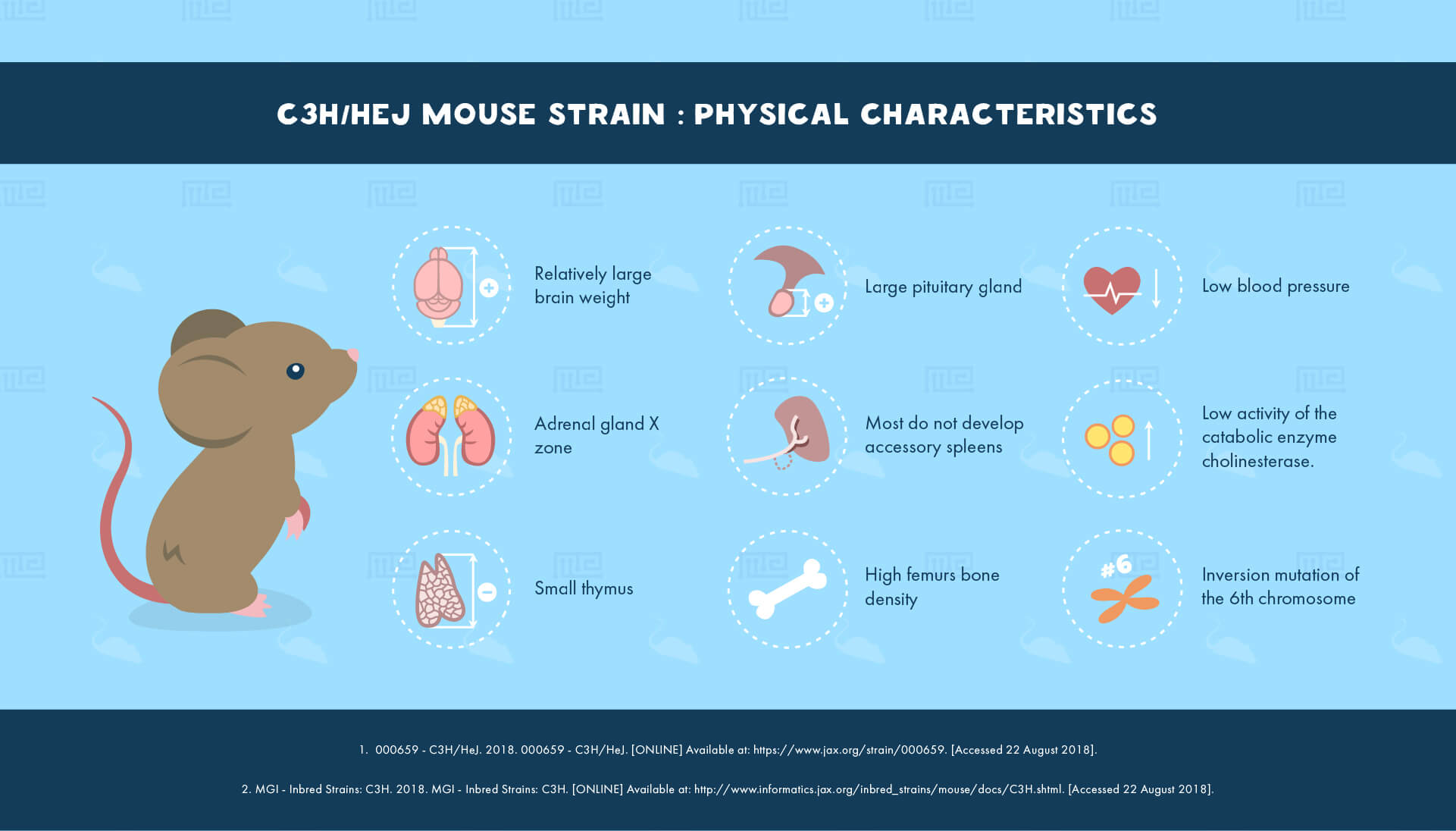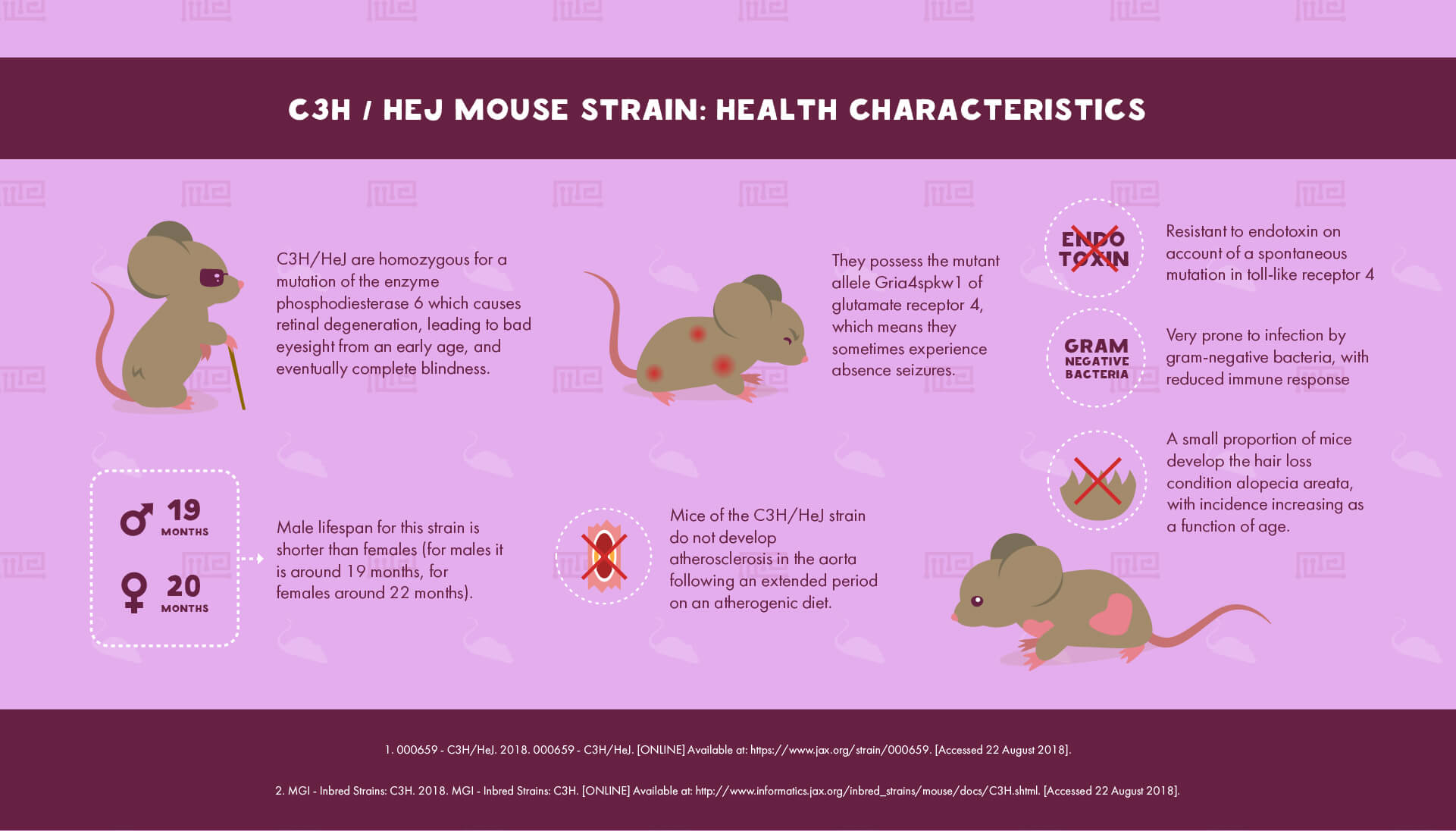Overview
C3H/HeJ, also known as C3H and C3H Heston, is one of the most popular strains of inbred mouse models and is used in many areas of research.
History
The C3H strain was created by Strong in 1920. A DBA mouse was crossed with a Bagg albino, selected for a high prevalence of mammary cancer. This cancer was caused by the mouse mammary tumor virus in the mother’s milk.
The C3H substrains maintained now are all free from this virus, after being rederived in 1999 as part of an effort to make the mice healthier. The most commonly used C3H/HeJ substrain spontaneously acquired a toll-like receptor mutation, sometime in the late 1960s, which sets it apart genetically from the other C3H substrains.[1]
Physical Characteristics
C3H/HeJ mice have light brown fur.[1] They have a relatively large brain weight, but a small brain to body size ratio, a small thymus, a large pituitary gland, and adrenal gland X zone. Their femurs have a high bone density, and most do not develop accessory spleens.[2]
Their blood pressure is low, but their serum cholesterol and triglyceride concentrations are high. This latter is most probably due to low activity of the catabolic enzyme cholinesterase. Their 6th chromosome has experienced a spontaneous inversion mutation which appears to have no noticeable effects.[2]
Need Mazes for your research?
Behavioral Characteristics & Handling
One study reports low aggression between individuals of this strain.[3] This appears to translate to the realm of human handling: as a Canadian study[4] comparing the ease of handling of different mouse strains reports, C3H/HeJ mice are quite placid. Struggling when held and evasive behavior when captured were low, although squeaking was intermediate.
Researchers should thus generally feel confident in handling this strain, although those needing an extremely placid mouse might want to opt for BALB/cByJ or A/J instead.
Data on spatial learning and memory in this strain is complicated: they show good performance in the T maze, but poor performance in the Morris water maze and radial arm maze.[2] One study claims that they have good short-term memory but a poor long-term memory.[5] In light of these discrepancies, researchers wishing to conduct studies on spatial learning and memory might want to avoid this strain.
Observations of motor activity in this strain are similarly difficult to interpret. Whilst their open field activity is low, they do not remain immobile for very long in a forced swimming test.[2] Breeding performance is described as good, with large litters.[2]
Health Characteristics
Like many common mouse strains, C3H/HeJ are homozygous for a mutation of the enzyme phosphodiesterase 6 which causes retinal degeneration, leading to bad eyesight from an early age, and eventually complete blindness.[1]
Unlike many susceptible strains such as C57BL/6J, mice of the C3H/HeJ strain do not develop atherosclerosis in the aorta following an extended period on an atherogenic diet (high fat and high cholesterol).[1][2]
While mammary tumors are now rare in this strain, they can still occur. Hepatomas are much more common, especially in males where incidence can be as high as 90%. As a result, male lifespan for this strain is shorter than females (for males it is around 19 months, for females around 22 months).[1][2]
A small proportion of C3H/HeJ mice develop the hair loss condition alopecia areata, with incidence increasing as a function of age. White colored spots of hair on their underside are also commonly seen.[1]
These mice are resistant to endotoxin on account of a spontaneous mutation in toll-like receptor 4. They are however also very prone to infection by gram-negative bacteria, with a reduced immune response.[1]
They possess the mutant allele Gria4spkw1 of glutamate receptor 4, which means they sometimes experience absence seizures. These seizures are attenuated by another mutant allele Pcnx2.[1]
Major Experimental Uses
C3H/HeJ is a general purpose strain, and so is used for a huge range of different research applications, including studies on liver and mammary cancer, atherosclerosis, immunodeficiency, epilepsy, and retinal degeneration. They are recommended as a host for several kinds of transplantable tumors.[1]
References
- 000659 – C3H/HeJ. 2018. 000659 – C3H/HeJ. [ONLINE] Available at: https://www.jax.org/strain/000659. [Accessed 22 August 2018].
- MGI – Inbred Strains: C3H. 2018. MGI – Inbred Strains: C3H. [ONLINE] Available at: http://www.informatics.jax.org/inbred_strains/mouse/docs/C3H.shtml. [Accessed 22 August 2018].
- Southwick C. H. and Clark L. H. (1966) Aggressive behavior and exploratory activity in fourteen mouse strains. Zool. 6, 559.
- Wahlsten, D. Metten, P. Crabbe, JC. 2003. A rating scale for the wildness and ease of handling laboratory mice: results for 21 inbred strains tested in two laboratories. Genes, Brain and Behavior. 2; 71-79.
- Bovet D., Bovet-Nitti F., and Oliverio A. (1969) Genetic aspects of learning and memory in mice. Science 163, 139-149.


